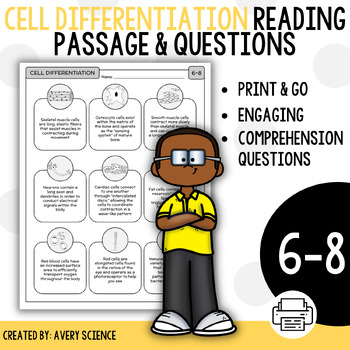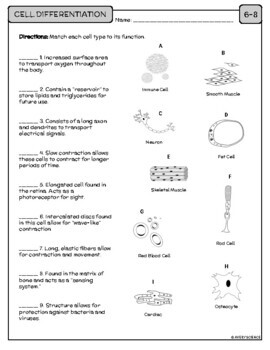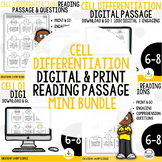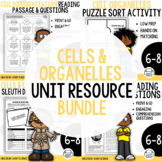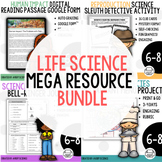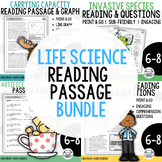Cell Differentiation and Specialization Reading Passage and Questions
What educators are saying
Also included in
- Overview:Cell differentiation can be a challenging concept for students, especially if they have been looking at traditional cell models and diagrams that only show one type of cell. This introductory reading passage, examples page, and comprehension question assignment is the perfect transition toPrice $4.80Original Price $6.00Save $1.20
- Overview:Refresh your cells unit with this cells and organelles bundle. The unit "booster" is best for teachers that already have a curriculum in place and are looking to refresh their resources and increase engagement through varied activities. This bundle contains easy, print and go resources, asPrice $43.40Original Price $54.25Save $10.85
- Overview:Are you a middle school science teacher looking to boost engagement with clean, high-quality life science materials? Do you have an existing curriculum that needs to be refreshed? Check out this life science mega resource bundle from Avery Science! You'll receive all of my unit resource bunPrice $580.95Original Price $645.50Save $64.55
- Overview:Engage your middle school students in a variety of life science topics with this life science reading passage bundles! These passages are written with middle schoolers in mind and contain a variety of matching activities, questions, and even graphing activities. Reading passages are a sub-fPrice $52.85Original Price $75.50Save $22.65
Description
Overview:
Cell differentiation can be a challenging concept for students, especially if they have been looking at traditional cell models and diagrams that only show one type of cell. This introductory reading passage, examples page, and comprehension question assignment is the perfect transition to cell differentiation for your middle school students! This is an awesome assignment for students if your time is limited for cell differentiation or you aren't able to do a full stem cell project.
Why You'll Love It:
- This resource is designed with middle schoolers in mind and places the focus on cell differentiation.
- This passage connects to the levels of organization. A great review or introduction to this concept, connected with cell differentiation.
- A perfect analogy. Your students will understand differentiation with a clever comparison to different types of jobs.
- Tons of examples with accompanying images. Your students will really understand what cell differentiation looks like. This resource includes an example page with 9 different types of cells along with descriptions about structure and function.
Students Will:
- Read a one-page passage about cell differentiation
- View 9 visual examples with descriptions of different types of cells and how they are differentiated
- Answer five open-ended reading comprehension questions
- Match the cell examples to their functions
Included in this Resource:
- One-page reading passage
- Differentiation example page (9 types of cells included)
- Five comprehension questions
- Matching worksheet
- Answer key
Are you looking for other awesome resources to teach your cells unit? Check out some of my favorites below!
- Cells & Organelles Kaboom! Review Game
- Organelles Cell Analogy Graphic Organizer
- Cells & Organelles Open-Ended Task Cards
- Cells Unit Boosting Bundle
- Organelles Matching Worksheet
- Cellulose Reading Passage & Questions
Terms of Use:
You May:
- Use free and purchased items for your own classroom students, or your own personal use.
- Reference this product in blog posts, at seminars, professional development, workshops, or other such venues, ONLY if both credit is given to myself as the author, and a link back to my TpT store is included in the presentation.
- Purchase licenses at a great discount for other teachers to use this resource.
You May Not:
- Claim this work as your own, alter the files in any way, or remove copyright / watermarks.
- Sell the files or combine them into another unit for sale / free.
- Post this document for sale / free elsewhere on the internet (this includes Google Doc links on blogs).
- Making copies of purchased items to share with others is strictly forbidden and is a violation of the TOU / law.
Clipart and fonts for cover images credit to: Educlips, Hello Literacy, KG Fonts

